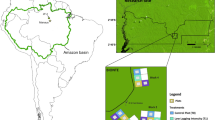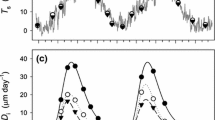Abstract
CO2 efflux (ECO2) from stems and branches is highly variable within trees. To investigate the mechanisms underlying the temporal dynamics and vertical variations in ECO2, we measured the stem ECO2 by infrared gas analysis (IRGA) and meteorological conditions at 10 different heights from 0.1 to 3.7 m aboveground on two consecutive days every month for 1 year in six Styphnolobium japonicum trees with a similar size. The results indicated that the seasonal change in ECO2 roughly followed the seasonal variations in woody tissue temperature (TW) and stem radial diameter increment (Di). Together, TW and Di explained the monthly change in ECO2, and the contributions of TW and Di changed with the stem positions and growth stages. The diurnal patterns of ECO2 differed greatly between the growing and dormant season, showing a bimodal distribution with an obvious midday depression in the former and a unimodal distribution in the latter. The strong vertical variation in the day-time ECO2 of the growing season was mainly caused by the vertical gradients of TW, Di and difference in sapwood volume per unit of the stem surface along the trunk. The temperature-sensitivity coefficient (Q10) was not constant, as assumed in some models, but was instead vertically altered and highly dependent on the measurement temperature. For all stem positions, the highest Q10 value appeared at approximately 5 °C, and both higher and lower temperatures decreased Q10. Our study demonstrated that application of a constant Q10 would cause an estimation error when scaling up chamber-based measurements to annual carbon budgets at the whole-stem level.





Similar content being viewed by others
References
Acosta M, Pavelka M, Pokorný R, Janouš D, Marek MV (2008) Seasonal variation in CO2 efflux of stems and branches of Norway spruce trees. Ann Bot 101:469–477
Araki MG, Utsugi H, KajimotoT, Han Q, Kawasaki T, Chiba Y (2010) Estimation of whole-stem respiration, incorporating vertical and seasonal variations in stem CO2 efflux rate of Chamaecyparis obtusa trees. J For Res 15:115–122
Araki MG, KajimotoT, Han Q, Kawasaki T, Utsugi H, Gyokusen K, Chiba Y (2015) Effect of stem radial growth on seasonal and spatial variations in stem CO2 efflux of Chamaecyparis obtusa. Trees Struct Funct 29:499–514
Atkin OK, Tjoelker MG (2003) Thermal acclimation and the dynamic response of plant respiration to temperature. Trends Plant Sci 8:343–351
Atkin OK, Zhang QS, Wiskich JT (2002) Effect of temperature on rates of alternative and cytochrome pathway respiration and their relationship with the redox poise of the quinone pool. Plant Physiol 128:212–222
Brito P, Morales D, Wieser G, Jiménez MS (2010) Spatial and seasonal variations in stem CO2 efflux of Pinus canariensis at their upper distribution limit. Trees Struct Funct 24:523–531.
Cavaleri MA, Oberbauer SF, Ryan MG (2006) Wood CO2 efflux in a primary tropical rain forest. Glob Change Biol 12:2442–2458
Cernusak LA, Hutley LB, Beringer J, Tapper NJ (2006) Stem and leaf gas exchange and their responses to fire in a north Australian tropical savanna. Plant Cell Environ 29:632–646
Ceschia É, Damesin C, Lebaube S, Pontailler JY, Dufrêne É (2002) Spatial and seasonal variations in stem respiration of beech trees (Fagus sylvatica). Ann For Sci 59:801–812
Chambers JQ, Tribuzy ES, Toledo LC, Santos J, Crispim BF, Higuchi N, Araújo C, Kruijt B, Nobre AD, Trumbore SE (2004) Respiration from a tropical forest ecosystem: partitioning of sources and low carbon use efficiency. Ecol Appl 14:72–88
Covey-Crump EM, Attwood RG, Atkin OK (2002) Regulation of root respiration in two species of Plantago that differ in relative growth rate: the effect of short- and long-term changes in temperature. Plant Cell Environ 25:1501–1513
CurielYuste J, Janssens IA, Carrara A, Ceulemans R (2004) Annual Q10 of soil respiration reflects plant phenological patterns as well as temperature sensitivity. Glob Change Biol 10:81–94
Damesin C, Ceschia E, LeGoff N, Ottorini JM, Dufrêne É (2002) Stem and branch respiration of beech: from tree measurements to estimations at the stand level. N Phytol 153:159–172
Edwards NT, Hanson PJ (1996) Stem respiration in a closed-canopy upland oak forest. Tree Physiol 16:433–439
Harris NL, Hall CAS, Lugo AE (2008) Estimates of species- and ecosystem-level respiration of woody stems along an elavational gradient in the Luduillo Mountains, Puerto Rico. Ecol Model 216:253–264.
Katayama A, Kume T, Komatsu H, Ohashi M, Matsumoto K, Ichihashi R, Kumagai T, Otsuki K (2014) Vertical variations in wood CO2 efflux for live emergent trees in a Bornean tropical rainforest. Tree Physiol 34:503–512
Levy PE, Jarvis PG (1998) Stem CO2 fluxes in Two Sahelian Shrub Species (Guiera senegalensis and Combretum micranthum). Funct Ecol 12:107–116
Loveys BR, Atkinson LJ, Sherlock DJ, Roberts RL, Fitter AH, Atkin OK (2003) Thermal acclimation of leaf and root respiration: an investigation comparing inherently fast- and slow growing plant species. Glob Change Biol 9:895–910
Mahecha MD, Reichstein M, Carvalhais N, Lasslop G, Lange H, Seneviratne SI, Vargas R, Ammann C, Arain MA, Cescatti A, Janssens IA, Migliavacca M, Montagnani L, Richardson AD (2010) Global convergence in the temperature sensitivity of respiration at ecosystem level. Science 329:838–840
Maier CA, Clinton BD (2006) Relationship between stem CO2 efflux, stem sap velocity and xylem CO2 concentration in young loblolly pine trees. Plant Cell Environ 29:1471–1483
Maier CA, Albaugh TJ, Allen HL, Dougherty PM (2004) Respiratory carbon use and carbon storage in mid-rotation loblolly pine (Pinus taeda L.) plantations: the effect of site resources on the stand carbon balance. Glob Change Biol 10:1335–1350
Maunoury F, Berveiller D, Lelarge C, Pontailler JY, Vanbostal L, Damesin C (2007) Seasonal, daily and diurnal variations in the stable carbon isotope composition of carbon dioxide respired by tree trunks in a deciduous oak forest. Oecologia 151:268–279
McGuire MA, Cerasoli S, Teskey RO (2007) CO2 fluxes and respiration of branch segments of sycamore (Platanus occidentalis L.) examined at different sap velocities, branch diameters, and temperatures. J Exp Bot 58:2159–2168
Melillo JM, McGuire AD, Kicklighter DW, Moore B, Vorosmarty CJ, Schloss AL (1993) Global climate change and terrestrial net primary production. Nature 363:234–240
Paembonan SA, Hagihara A, Hozumi K (1991) Long-term measurement of CO2 release from the above ground parts of a Hinoki Forest tree in relation to air temperature. Tree Physiol 8:399–405
Robertson AL, Malhi Y, Farfan-Amezquita F, Aragão LEOC, Silva Espejo JE, Robertson MA (2010) Stem respiration in tropical forests along an elevation gradient in the Amazon and Andes. Glob Change Biol 16:3193–3204
Ryan MG (1991) Effects of climate change on plant respiration. Ecol Appl 1:157–167
Ryan MG, Hubbard RM, Clark DA, Sanford RL (1994) Woody-tissue respiration for Simarouba amara and Minquartia guianensis, two tropical wet forest trees with different growth habits. Oecologia 100:213–220
Ryan MG, Gower ST, Hubbard RM, Waring RH, Gholz LH, Cropper WP, Running SW (1995) Woody tissue maintenance respiration of four conifers in contrasting climates. Oecologia 101:133–140
Ryan MG, Binkley D, Fownes JH (1997) Age-related decline in forest productivity: pattern and process. Adv Ecol Res 27:213–262
Ryan MG, Cavaleri MA, Almeida AC, Penchel R, Senock RS, Stape JL (2009) Wood CO2 efflux and foliar respiration for Eucalyptus in Hawaii and Brazil. Tree Physiol 29:1213–1222
Saveyn A, Steppe K, Lemeur R (2007) Daytime depression in tree stem CO2 efflux rates: is it caused by low stem turgor pressure? Ann Bot 99:477–485
Slot M, Kitajima K (2015) General patterns of acclimation of leaf respiration to elevated temperatures across biomes and plant types. Oecologia 177:885–900
Steppe K, Saveyn A, McGuire MA, Lemeur R, Teskey RO (2007) Resistance to radial CO2 diffusion contributes to between-tree variation in CO2 efflux of Populus deltoides stems. Funct Plant Biol 34:785–792
Stitt M, Hurry VM (2002) A plant for all seasons: alteration in photosynthetic carbon metabolism during cold acclimation in Arabidopsis. Curr Opin Plant Biol 5:199–206
Stockfors J (2000) Temperature variations and distribution of living cells within tree stems: implications for stem respiration modelling and scale-up. Tree Physiol 20:1057–1062
Stockfors J, Linder S (1998) Effect of nitrogen on the seasonal course of growth and maintenance respiration in stems of Norway spruce trees. Tree Physiol 18:155–166
Tarvainen L, Räntfors M, Wallin G (2014) Vertical gradients and seasonal variation in stem CO2 efflux within a Norway spruce stand. Tree Physiol 34:488–502
Teskey RO, Saveyn A, Steppe K, McGuire MA (2008) Origin, fate and significance of CO2 in tree stems. N Phytol 177:17–32
Thorley JHM, Cannell MGR (2000) Modelling the components of plant respiration: representation and realism. Ann Bot 85:55–67
Tjoelker MG, Oleksyn J, Reich PB (2001) Modelling respiration of vegetation: evidence for a general temperature-dependent Q10. Glob Change Biol 7:223–230
Turnbull MH, Whitehead D, Tissue DT, Schuster WSF, Brown KJ, Griffin KL (2001) Responses of leaf respiration to temperature and leaf characteristics in three deciduous tree species vary with site water availability. Tree Physiol 21:571–578
Valentini R, De Angelis P, Matteucci G, Monaco R, Dore S, Scarascia Mugnozza GE (1996) Seasonal net carbon dioxide exchange of a beech forest with the atmosphere. Glob Change Biol 2:199–207
Vose JM, Ryan MG (2002) Seasonal respiration of foliage, fine roots, and woody tissues in relation to growth, tissue N, and photosynthesis. Glob Change Biol 8:182–193
Wieser G, Bahn M (2004) Seasonal and spatial variation of woody tissue respiration in a Pinus cembra tree at the alpine timberline in the central Austrian Alps. Trees Struct Funct 18:576–580
Xu M, DeBiase TA, Qi Y (2000) A simple technique to measure stem respiration using a horizontally oriented soil chamber. Can J For Res 30: 1555–1560
Xu F, Wang CK, Wang XC (2011) Intra- and inter-specific variations in stem respiration for 14 temperate tree species in northeastern China. Acta Ecol Sin 31: 3581–3589
Yang QP, Xu M, Chi YG, Zheng YP, Shen RC, Li PX, Dai HT (2012) Temporal and spatial variations of stem CO2 efflux of three species in subtropical China. J Plant Ecol 5: 229–237
Yang Y, Zhao M, Xu X, Sun Z, Yin G, Piao S (2014) Diurnal and seasonal change in stem respiration of Larix principis-rupprechtii trees, northern China. Plos One 9: e89294
Zha T, Kellomäki S, Wang KY, Ryyppö A, Niinistö S (2004) Seasonal and annual stem respiration of Scots pine trees under boreal conditions. Ann Bot 94: 889–896
Acknowledgements
This research was supported by the National Natural Science Foundation of China (41171442, 41571482), the State Key Laboratory of Urban and Regional Ecology (SKLURE 2013-1-01) and the programs of the Chinese Academy of Sciences during the 13th Five-Year Plan Period (YSW2013B04).
Author information
Authors and Affiliations
Corresponding author
Electronic supplementary material
Below is the link to the electronic supplementary material.
Rights and permissions
About this article
Cite this article
Han, F., Wang, X., Zhou, H. et al. Temporal dynamics and vertical variations in stem CO2 efflux of Styphnolobium japonicum . J Plant Res 130, 845–858 (2017). https://doi.org/10.1007/s10265-017-0951-3
Received:
Accepted:
Published:
Issue Date:
DOI: https://doi.org/10.1007/s10265-017-0951-3




